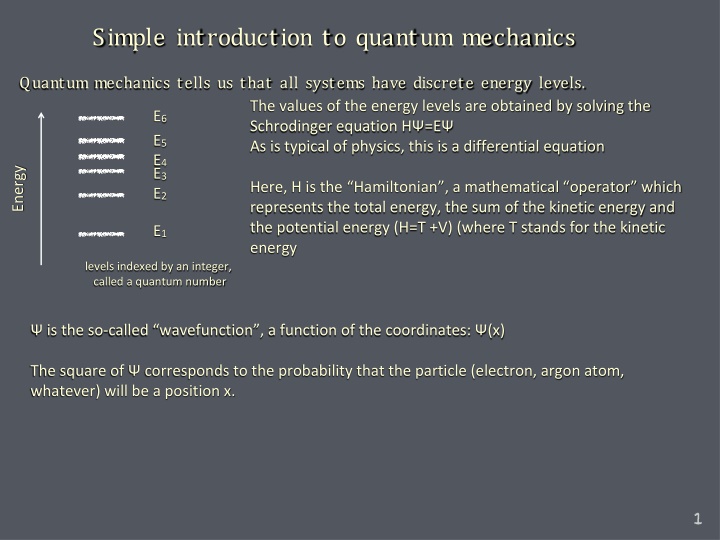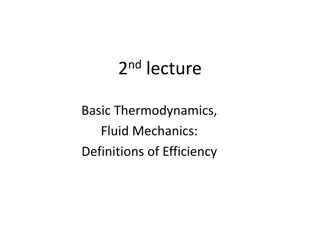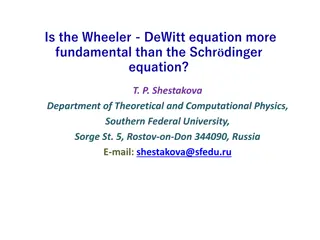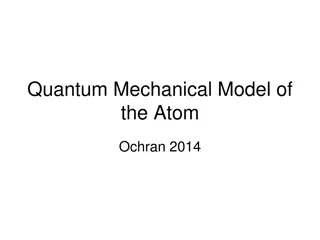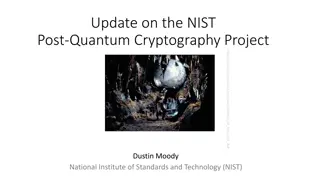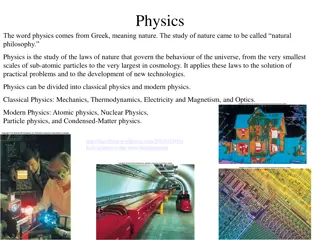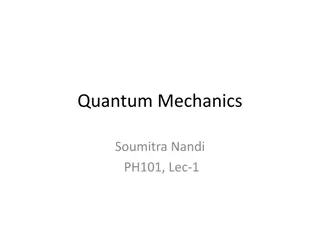Introduction to Quantum Mechanics: Energy Levels and Schrödinger Equation
Quantum mechanics reveals that all systems possess discrete energy levels, determined by solving the Schrödinger equation where the Hamiltonian operator represents total energy. In a particle-in-a-box scenario, potential energy is infinite outside the box. The Schrödinger equation simplifies to a second-order differential equation, yielding solutions in the form of sin or cosine functions. These solutions represent the probability of particle presence at a certain position, with probability zero at points of infinite potential.
Download Presentation

Please find below an Image/Link to download the presentation.
The content on the website is provided AS IS for your information and personal use only. It may not be sold, licensed, or shared on other websites without obtaining consent from the author.If you encounter any issues during the download, it is possible that the publisher has removed the file from their server.
You are allowed to download the files provided on this website for personal or commercial use, subject to the condition that they are used lawfully. All files are the property of their respective owners.
The content on the website is provided AS IS for your information and personal use only. It may not be sold, licensed, or shared on other websites without obtaining consent from the author.
E N D
Presentation Transcript
Simple introduction to quantum mechanics Quantum mechanics tells us that all systems have discrete energy levels. The values of the energy levels are obtained by solving the Schrodinger equation H =E As is typical of physics, this is a differential equation E6 E5 E4 E3 Energy Here, H is the Hamiltonian , a mathematical operator which represents the total energy, the sum of the kinetic energy and the potential energy (H=T +V) (where T stands for the kinetic energy E2 E1 levels indexed by an integer, called a quantum number is the so-called wavefunction , a function of the coordinates: (x) The square of corresponds to the probability that the particle (electron, argon atom, whatever) will be a position x.
Lets look at an example: The easiest example is a particle-in-a-box, a particle of mass m confined to the range 0 x a (where a is a constant). Inside the box (0 x a), the potential energy is 0, outside the box (x>a and x<0) the potential energy is infinite. This is a hypothetical system (because it s only one dimensional) but in three dimensions just an extension of 1 dimension it becomes a three dimensional box. The 3 dimensional particle-in-box is the model for the translational motion of a any gas in a container, of volume V=a3. x 0 a The potential energy is zero (inside). The operator for the kinetic energy is Here is the reduced Planck s constant, called h-bar . This is a funny expression, because it contains the second derivative, but of what?
Remember that in classical mechanics, the kinetic energy is just T= mv2. Here v, the velocity, is dx/dt (a first derivative of the position with respect to time. This is a very different expression. Since the potential energy V(x) is zero inside the box, the Scrodinger equation reduces to: H =E T =E or Now we can define a new variable , so that the Schrodinger equation becomes This is a very simple differential equation. The second derivative of the solution (x) is exactly equal to the solution multiplied by the constant k2. You may be more comfortable seeing the equation as
Because its a 2nd order equation (2nd derivative), there are two linearly independent solutions. In other words f(x) can be two different functions which are not related by multiplication by a constant. The equation is one of the simplest differential equations. The two linearly independent solutions are f(x)=Acos(kx) (where A is a constant) and f(x)=Asin(kx). Problem for you: show that these two solutions do satisfy the differential equation Thus, the solution to the Schrodinger equation for the particle-in-a-box is just (x)=Acos(kx) or (x)=Asin(kx). Now remember that (x)2 is the probability that the particle can be found at position x. The potential for the particle in a box is postively infinite when x=0 and x=a. Whenever the potential is infinite, the probability of finding the particle there is nul (zero). x 0 a
Thus at x=0 and x=a, (x) must go to zero, or, mathematically, (0)=(a)=0 Now we know that cos(0)=1, so the cos(kx) solution can t be valid. So we have to chose (x)=Asin(kx). This certainly vanishes at x=0. But what about x=a. At that value of x we have (x=a)=Asin(ka). In general sin(x) vanishes only when x is an integer multiple of . Thus, we can have an allowed wavefunction, one that vanishes at both x=0 and x=a, only when ka=n , where n is a positive integer. We remember that . If we put this into the last equation, we have . We can solve this for the energy E, obtaining
This equation, illustrates a key feature of quantum mechanics: The value of the energy, even for a system as simple as a particle-in-a-box, can have only discrete values. The quantity n is called the quantum number . Consider a classical particle in the same box. Because the potential energy is zero, the total energy is just the kinetic energy, with value E = T= mv2. Since all values of the velocity are allowed, all values of the energy will be allowed. This is a key difference with quantum mechanics, where only discrete energy states occur. The crucial point is the requirement that the wavefunction be well behaved at the limits of the range of the independent variable x. Note that the quantum number appears in the denominator (and squared). Thus as the quantum number increases, the energy levels will draw apart quadratically.
This equation, illustrates a key feature of quantum mechanics: The value of the energy, even for a system as simple as a particle-in-a-box, can have only discrete values. The quantity n is called the quantum number . Consider a classical particle in the same box. Because the potential energy is zero, the total energy is just the kinetic energy, with value E = T= mv2. Since all values of the velocity are allowed, all values of the energy will be allowed. This is a key difference with quantum mechanics, where only discrete energy states occur. The crucial point is the requirement that the wavefunction be well behaved at the limits of the range of the independent variable x. n=4 2 Note that the quantum number appears in the numerator (and squared). Thus as the quantum number increases, the energy levels will draw apart quadratically, as shown on the right. 2 Energy / in units of 2 n=3 n=2 n=1
The same quantization applies to a number of other simple model physical systems, that can be applied to many physically and chemically interesting systems. Harmonic Oscillator A harmonic oscillator is an excellent model for the vibrational motion of atoms relative to their equilibrium positions. We assume Hooke s law whereby the force that returns the atomic positions to their equilibrium values is inversely proportional to the displacement from equilbrium. F = - k (x-xo), where xo designates the equilbrium position and k is the force constant (not the same thing as the wavevector k which we introduced earlier in simplifying the Schrodinger equation for the particle-in-a-box. Since the force is defined in physics as the negative first derivative of the potential, the potential for the harmonic oscillator is V(x-xo) = kx2. Here k is called the force constant, which is different from the k (called the wavevector) which we introduced earlier in our solution of the Schrodinger equation for the particle-in-a-box.
Here is the potential for the harmonic oscillator x xo The kinetic energy operator in the Schrodinger equation is unchanged from the particle-in-a- box. The boundary condition on the wavefunction is also the same: (x) must go to zero whenever the potential is infinite. You can show mathematically that this condition can be achieved only for values of the energy which satisfy the equation. En = (n+ )h? , where Here k is the force constant and ?is the reduced mass (the effective mass of the oscillator). For a diatomic molecule A B, the reduced mass is ?= ma mb/ (ma + mb). The quantity ? is called the frequency of the oscillator. Its units are s 1 (or commonly called cycles per second). Note that the angular frequency (radians per second), often designated , is 2 ?. For the harmonic oscillator, the quantum numbers run from n=0 to infinity. The energy levels are equally spaced, h? apart. Note that the lowest energy level (n=0) is h?, not zero! This is the so-called zero-point energy of the oscillator.
Here are the energy levels of the harmonic oscillator superposed on the harmonic oscillator potential. Note that the lowest level is only h? above the bottom of the well. [I think Fig. 1.6 of the book is incorrect, because it shows the n=0 level to be about h? (not h?) above]. 3 2 1 n=0 x xo Rigid Rotator The rigid rotator is an excellent model for the rotation of molecules (it s only a model because a real molecule stretches as it rotates faster). The rigid rotator is well described in Sec. 1-8 of the text. The energy levels are proportional to the square of the total angular momentum J EJ = ( 2/2I) J(J+1) The angular momentum is a vector which is directed perpendicular to the plane of rotation (the plane of rotation is well illustrated in Fig. 1.8). This plane can be arbitrarily tilted without changing the physics of rotation. Thus, there can be other orientation of the rigid rotator which have the same energy. The number of different allowed orientations of is equal to (2J+1).
This factor (2J+1) is called the degeneracy of the level the number of times a given value of the energy occurs for a different set of quantum The angular momentum is a vector which is directed perpendicular to the plane of rotation (the plane of rotation is well illustrated in Fig. 1.8) This plane can be arbitrarily tilted without changing the physics of rotation. Thus, there can be other orientation of the rigid rotator which have the same energy. In quantum mechanics the number of different allowed orientations of is equal to (2J+1). Hydrogen Atom The hydrogen atom is the model for our understanding of the electronic structure of atoms, and, ultimately, molecular bonding. An electron rotating around a proton has the same spherical symmetry as the rigid rotator. Thus, all the states of the hydrogen atom are characterized by an angular momentum (which is called ? instead of J) and they all have a degeneracy of (2? +1). Levels with ?=0, 1, 2, are designated s , p , d ,
In contrast to the rigid rotator, the electron in the H atom is free to move in and out. The radius of rotation r can vary, subject to the attractive Coulomb potential Here e is the electronic charge and the quantity o is called the permittivity of the vacuum (you don t need to worry about this). With this potential, the Schrodinger equation can be solved. The wavefunctions are the H- atom orbitals, which you ve learned about in your freshman year. The energy levels are given by the expression Here, R (the so-called Rydberg constant, here given in units of energy) is R = - 2.179 10 18 J. Note that there is no dependence on the angular momentum ?. All levels with the same n (the principal quantum number) have the same energy. This is an additional degeneracy of the H atom. As seen in Fig. 1.1, because the energy levels depend inversely (quadratically) on n, there are an infinite number of levels with energy below zero.
